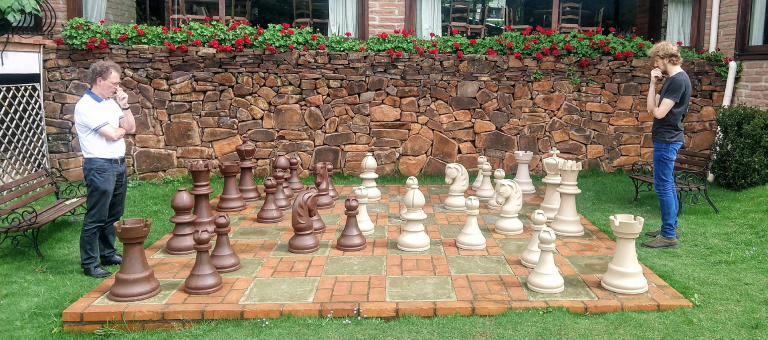What I love about chess
Jan 27, 2022 ~ 3 min read
Playing chess with a big boss from SAP back in 2019 during a team offsite. I lost horribly.
I started playing chess at the end of 2018. My brother and I were working at the same company, and there was a chessboard in the area we had lunch every day. We knew the rules and how the pieces move (except “en passant”), so we started playing a couple of games after eating whatever we brought from home for the day.
Both he and I are stats' geeks, so we kept a score of the 99 games we played before he took another job. During the time we were playing, I started to consume videos from a few different youtube channels. I can’t remember if I went after chess content myself or if my phone spied on me and sent me ads, but—I fell in love with the game and started to get a lot better. So much better, in fact, that my brother who was playing just for fun, couldn’t beat me anymore.
Since then, I have frequently played on chess.com. Here’s how it goes on and on: I set personal goals, learn from puzzles and youtube, improve, inexplicably lose a bunch of games, get frustrated, and restart the process. But a few things make this game different from the others, and these are the things I love about chess:
1. Never the same
The game always starts with the same position. White starts the game and has 20 different moves to choose from. Black has the same 20 moves to respond. From this moment, possibilities grow wildly. So after each player moves once, there are 400 possible positions. After each player moves twice there are 197,742 possible positions and, after 3 moves, 121 million (although most of these positions will hardly be achieved since they’re horrible for one of the players.)
2. The game is fair
In online chess (and official rankings which I’m far from being part of) you have an ELO. It’s a number determined by a complex algorithm that shows “how good you are”, and chess platforms use it to pair you with your opponents. At the moment I’m writing this, my ELO is around 1550 at blitz (3 to 5 minutes for each player) at chess.com.
Every time I win a game, I earn a few ELO points and my opponent loses some. The opposite happens to me when I lose, of course. Thus, the number of points I earn is defined by the ELO of my opponent. This way, the more games I win, the higher my ELO, and consequently, better opponents will be paired with me.
3. There is no “being good at”
After playing a few first games, your ELO will be established. From this moment, you can easily measure your evolution. The chart below shows my personal growth in the span of three years, going from 677 to 1587.

My progress at blitz in chess.com — from 677 in Dec 2018 to 1587 in Dec 2021.
I was not good at 677, and I’m not good at 1587 either. But I’m better, and I want to and will improve much more. Although I know I won’t get close to the Grand Master level, I do know I’ll have fun playing exciting games, exercising my brain, learning more every day, and meeting extraordinary people because of this not-boring-at-all, amazing old game.